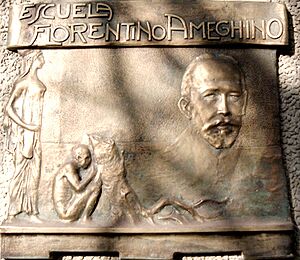Florentino Ameghino facts for kids
Quick facts for kids
Florentino Ameghino
|
|
|---|---|

Florentino Ameghino
|
|
| Born | September 19, 1853 Moneglia, Kingdom of Sardinia
|
| Died | August 6, 1911 (aged 57) |
| Resting place | La Plata Cemetery |
| Nationality | Argentine |
| Awards | Bronze medal at the Exposition Universelle (1889) for Mammalian Fossils in the Argentine Republic. |
| Scientific career | |
| Fields | Paleontology |
| Influences | Charles Darwin Jean-Baptiste Lamarck Charles Lyell |
| Influenced | Juan Bautista Ambrosetti |
Florentino Ameghino (born Giovanni Battista Fiorino Giuseppe Ameghino; September 19, 1853 – August 6, 1911) was an Argentine naturalist, paleontologist, anthropologist, and zoologist. He made many important fossil discoveries in Argentina, especially in Patagonia. He worked with his two brothers, Carlos and Juan, and together they became key figures in South American paleontology.
From 1887 until his death, Ameghino focused on studying fossil mammals from Patagonia. His brother Carlos Ameghino (1865–1936) greatly helped him. Carlos made 14 trips to Patagonia between 1887 and 1902. He found many fossils and made important observations about the rock layers. These observations helped support Florentino's scientific work.
Contents
A Life of Discovery
Florentino Ameghino was born on September 19, 1853, in Moneglia, Italy. When he was about 18 months old, his family moved to Argentina. Ameghino was self-taught, meaning he learned a lot on his own. He loved studying the lands of the southern Pampas region in Argentina.
He built one of the world's largest collections of fossils at that time. This collection became the basis for his many studies in geology and paleontology. Ameghino was a leader in developing phylogenetics, which is the study of how living things are related through evolution. He also used a paleontological approach to evolutionary biology.
Ameghino also researched the possibility of prehistoric humans living in the Pampas. He made some interesting claims about where humans might have first appeared in South America. Domingo Faustino Sarmiento, who was president of Argentina from 1868 to 1874, once said that Ameghino was "admired by scholars worldwide."
Important Works and Recognition
In 1878, Ameghino published a book called The Antiquity of Man in the Río de la Plata. This book was later translated into French. In 1884, he published Phylogeny, a theoretical work about evolution based on Lamarckian ideas. This work helped establish zoological taxonomy as a scientific field using mathematical principles.
Later, he became the director of the Department of Zoology at the National University of Córdoba. The university gave him an honorary doctorate, which is a special degree. He also became a member of the National Academy of Sciences of Argentina.
Ameghino worked with Francisco P. Moreno, who founded the La Plata Museum. Ameghino was a deputy director, secretary, and later the director of the Paleontology Department when it started in 1888. He added his own huge fossil collection to the museum. He sold his collection to the government so it could be part of the museum.
A year later, in 1889, his most famous work, Mammalian Fossils in the Argentine Republic, was published. This huge book was over 1000 pages long and included an atlas. It won a bronze medal at the Exposition Universelle (1889) in Paris.
He later became the director of the Bernardino Rivadavia Natural Sciences Museum in Buenos Aires. In 1906, he published Sedimentary Formations of the Cretaceous and Tertiary Eras in Patagonia. This book not only described things but also offered ideas about how different mammals evolved. It also looked at different layers of the Earth's crust and their possible ages.
Between 1907 and 1911, Ameghino returned to studying anthropology. He described the first inhabitants of the region, their tools, and their cultures. He published 24 volumes of work, each with 700 to 800 pages. These books included classifications, studies, comparisons, and descriptions of more than 9000 extinct animals. Many of these animals he had discovered himself. This was a huge contribution to the list of known extinct mammals. Scientists from America and Europe used his collection and works for many years.
Florentino Ameghino passed away in La Plata in 1911 due to diabetes.
Legacy and Tributes
Many places and things are named in honor of Florentino Ameghino. The Ameghino Crater on the Moon is named after him. In Argentina, the Florentino Ameghino Partido and its main town, Ameghino, are named after him. The palaeontology journal Ameghiniana also carries his name.
Many other places in Argentina are named after him, including:
- The Parque Florentino Ameghino, a square in Buenos Aires.
- The Florentino Ameghino Department, an administrative area in Chubut Province.
- The Florentino Ameghino Dam, an artificial lake in Chubut Province.
- The petrified forest "Bosque Petrificado Florentino Ameghino" in Chubut Province.
- The school "Colegio Nacional Florentino Ameghino" in Mercedes, Buenos Aires Province.
- Ameghino Gully and Florentino Ameghino Refuge in Antarctica.
Images for kids
See also
- In Spanish: Florentino Ameghino for kids



